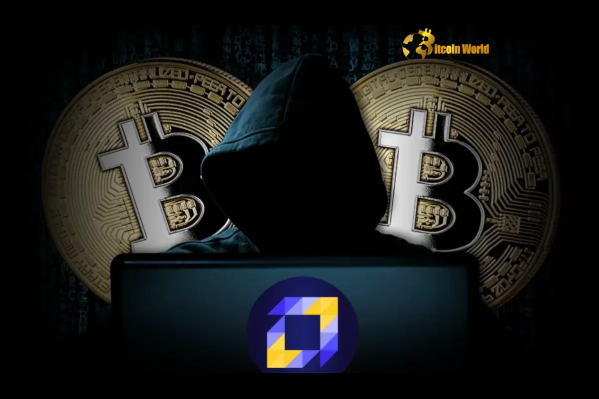BitcoinWorld

Bitcoin Futures: Unveiling the Massive 16K BTC Inflow & Its Market Impact
In the fast-paced world of cryptocurrency, sudden, massive movements of digital assets often signal important shifts. Recently, the crypto analytics firm CryptoQuant issued an alert that sent ripples through the market: a staggering influx of over 16,000 Bitcoin futures into various exchanges. This significant event has sparked widespread discussion and speculation among traders, analysts, and investors alike. What does such a substantial deposit of Bitcoin into futures platforms truly signify, and what could be its profound implications for the broader crypto landscape?
The CryptoQuant Revelation: A Staggering Inflow into Bitcoin Futures
On a recent day, the CryptoQuant Alert system, renowned for its on-chain insights, reported an astonishing movement: 16,624.65 BTC, valued at approximately $1.9 billion at the time, was deposited into multiple Bitcoin futures exchanges within a mere hour. This isn’t just a large number; it’s an extraordinary concentration of capital moving into a specific type of trading venue.
The breakdown of these inflows offers a fascinating glimpse into where this massive capital is being directed:
- Kraken: A dominant 16,258 BTC (approximately 97% of the total inflow)
- Binance: A notable 285 BTC (around 1% of the total)
- Bitfinex: A smaller but still significant 50 BTC (less than 1%)
What makes this particular inflow noteworthy, according to CryptoQuant, is that a substantial portion went into exchanges known for supporting custody solutions, often favored by institutional clients. This observation immediately raises the question: Are we witnessing the subtle, yet powerful, entry of big institutional money into the volatile world of Bitcoin futures?
Decoding the Movement: Why Do Bitcoin Futures Matter?
Before delving deeper into the implications of this massive inflow, it’s crucial to understand what Bitcoin futures are and why they play such a pivotal role in the cryptocurrency market. Essentially, a Bitcoin futures contract is an agreement to buy or sell a specified amount of Bitcoin at a predetermined price on a specific date in the future. Unlike spot trading, where assets are exchanged immediately, futures trading involves speculation on future price movements without owning the underlying asset directly.
Here’s why they are so significant:
- Price Discovery: Futures markets are often leading indicators for spot prices, as they reflect market participants’ collective expectations about future value.
- Hedging Opportunities: Traders and businesses can use futures to hedge against potential price volatility, protecting their existing Bitcoin holdings from adverse movements.
- Leveraged Speculation: Futures allow traders to open larger positions with a relatively small amount of capital (margin), amplifying both potential gains and losses.
- Institutional Access: For many traditional financial institutions, direct spot Bitcoin exposure can be complex due to regulatory and custodial concerns. Bitcoin futures, particularly those offered on regulated exchanges, provide a more familiar and compliant pathway to gain exposure to Bitcoin’s price movements.
Institutional Footprints: Is Big Money Entering Bitcoin Futures?
CryptoQuant’s emphasis on inflows to “custody-supporting exchanges” like Kraken is a key detail. Traditional financial institutions, such as hedge funds, asset managers, and corporate treasuries, typically require robust custody solutions to secure their digital assets. These solutions offer enhanced security, regulatory compliance, and insurance, which are non-negotiable for managing large sums of capital.
When significant amounts of Bitcoin flow into these specific types of exchanges, it strongly suggests that sophisticated players are preparing to engage with the market. Institutions often use Bitcoin futures for a variety of strategic reasons:
- Directional Bets: Taking a long (buy) or short (sell) position based on their outlook for Bitcoin’s price.
- Arbitrage Strategies: Exploiting price differences between the spot market and the futures market.
- Portfolio Diversification: Adding Bitcoin exposure to a diversified investment portfolio without the complexities of direct spot ownership.
- Yield Generation: Engaging in basis trading or other strategies that capitalize on the difference between spot and futures prices.
This inflow could be a precursor to increased institutional activity, potentially signaling a bullish sentiment if these institutions are entering long positions, or a hedging strategy if they are looking to protect existing spot holdings.
What This Means for the Market: Potential Impacts of Bitcoin Futures Inflows
A substantial inflow of BTC into Bitcoin futures exchanges can have several profound effects on the broader cryptocurrency market. Understanding these potential impacts is crucial for any investor looking to navigate the current landscape.
Increased Volatility and Price Swings
The most immediate effect of large capital inflows into futures markets is often an an increase in volatility. When significant positions are opened, particularly leveraged ones, any subsequent price movement can trigger cascades of liquidations, leading to sharp price swings. If the 16,000+ BTC inflow represents new, large positions, it could contribute to more dynamic price action in the coming days or weeks.
Shifting Market Sentiment
The nature of the inflow — whether it’s predominantly for long positions (bullish bets) or short positions (bearish bets) — will heavily influence market sentiment. While the raw inflow itself doesn’t explicitly state the direction, the fact that large players are committing capital suggests conviction. If these are predominantly long positions, it could signal growing confidence and potentially fuel a rally. Conversely, if they are opening short positions or hedging, it might indicate caution or a belief in an impending downturn.
Enhanced Liquidity and Market Depth
More capital flowing into Bitcoin futures markets generally leads to increased liquidity. Higher liquidity means that large orders can be executed with less price slippage, making it easier for both institutional and retail traders to enter and exit positions. This can create a more efficient and robust trading environment, which is generally a positive development for market maturity.
Impact on Funding Rates
In perpetual futures contracts, a mechanism called ‘funding rate’ keeps the futures price tethered to the spot price. A large influx of long positions can drive funding rates higher, meaning longs pay shorts, indicating bullish sentiment. Conversely, high short interest can lead to negative funding rates. Monitoring these rates can provide additional clues about the prevailing sentiment behind the massive Bitcoin futures inflow.
Navigating the Volatile Waters: Challenges and Considerations for Bitcoin Futures
While the entry of institutional capital into Bitcoin futures markets can be a sign of maturation, it also introduces certain challenges and considerations that investors should be aware of. The inherent nature of futures trading, especially with leverage, carries significant risks.
- Liquidation Risk: Futures trading often involves leverage, which amplifies both gains and losses. A small adverse price movement can lead to the liquidation of a position, resulting in substantial or even total loss of capital.
- Market Manipulation Concerns: Large players, whether institutional or whale traders, have the capacity to influence market prices. While regulated exchanges have safeguards, the potential for ‘wash trading’ or ‘spoofing’ tactics, though illegal, remains a concern in less regulated venues.
- Regulatory Scrutiny: As institutional interest grows, so does regulatory oversight. Changes in regulations surrounding Bitcoin futures could impact market dynamics and access.
- Complexity: Futures contracts can be more complex than spot trading, requiring a deeper understanding of margin, leverage, funding rates, and expiration dates.
For the average investor, understanding these risks is paramount. The presence of large institutional players doesn’t eliminate volatility; it can, in fact, contribute to it.
Actionable Insights for Crypto Enthusiasts
Given the significant inflow into Bitcoin futures, how can individual investors and traders respond to this information? Here are some actionable insights:
- Monitor On-Chain Data: Continue to follow alerts from firms like CryptoQuant. On-chain analytics provide invaluable insights into the movements of large holders and institutional activity.
- Observe Funding Rates and Open Interest: These metrics in the Bitcoin futures market can offer clues about the dominant sentiment. Rising open interest alongside positive funding rates might suggest bullish conviction, while rising open interest with negative funding rates could point to increasing bearish sentiment or hedging.
- Exercise Caution with Leverage: If you choose to engage in futures trading, understand the risks associated with leverage. Start small, use stop-loss orders, and never risk more than you can afford to lose.
- Diversify Your Portfolio: Don’t put all your eggs in one basket. While Bitcoin is a significant asset, a diversified portfolio can help mitigate risks associated with sudden market movements.
- Stay Informed: The crypto market evolves rapidly. Continuously educate yourself on market trends, technical analysis, and fundamental developments that could impact Bitcoin futures and the broader crypto ecosystem.
The Road Ahead: A Compelling Future for Bitcoin Futures?
The recent CryptoQuant alert, highlighting the massive 16,000+ BTC inflow into Bitcoin futures exchanges, underscores a critical juncture in the cryptocurrency market. It serves as a powerful reminder of the growing institutional appetite for digital assets and the increasing sophistication of market participants. Whether this inflow signals an impending price surge, a strategic hedging maneuver, or simply increased market depth, its implications are undeniable.
As Bitcoin continues its journey towards mainstream adoption, the role of derivatives markets, particularly Bitcoin futures, will only become more pronounced. These instruments provide essential tools for risk management, price discovery, and capital efficiency, attracting a broader range of participants. The market’s response to such significant capital movements will undoubtedly shape the narrative for the coming months, making it an exciting, albeit challenging, period for everyone involved in the crypto space. The future of Bitcoin, inextricably linked with its derivatives markets, promises continued evolution and intriguing developments.
Frequently Asked Questions (FAQs)
Q1: What is the significance of 16,000+ BTC flowing into futures exchanges?
A1: This significant inflow suggests a heightened interest from large players, potentially institutional clients, in leveraging Bitcoin futures for speculation, hedging, or arbitrage. It can indicate a major strategic move that could impact market volatility and sentiment.
Q2: Why did most of the BTC go to Kraken?
A2: Kraken is noted by CryptoQuant as a custody-supporting exchange, which means it offers secure, institutional-grade solutions for storing digital assets. This makes it a preferred venue for institutional clients who require robust security and compliance for their large capital movements.
Q3: Does this inflow guarantee a price increase for Bitcoin?
A3: Not necessarily. While large inflows can indicate bullish sentiment if new long positions are opened, they could also represent hedging strategies or short positions. The direction of the price movement depends on the aggregate sentiment of these large players and how their positions interact with the broader market.
Q4: How do Bitcoin futures differ from buying Bitcoin directly?
A4: When you buy Bitcoin directly (spot trading), you own the actual asset. Bitcoin futures contracts, on the other hand, are agreements to buy or sell Bitcoin at a future date for a predetermined price. You don’t own the underlying Bitcoin but speculate on its price movement, often with leverage.
Q5: What should individual investors do in response to such large inflows?
A5: Individual investors should monitor market metrics like funding rates and open interest, exercise caution with leveraged trading, consider diversifying their portfolios, and stay informed about market developments. It’s crucial to understand the risks involved and not to blindly follow large capital movements without personal due diligence.
Q6: How can I track similar institutional movements in Bitcoin futures?
A6: You can follow on-chain analytics platforms like CryptoQuant, Glassnode, or Nansen, which provide data and alerts on large whale movements, exchange flows, and institutional activity. Paying attention to news from reputable crypto media outlets also helps.
Share this insightful article with your network and spark a conversation about the profound implications of institutional capital in the crypto market! Your friends and followers will appreciate staying ahead of the curve.
To learn more about the latest Bitcoin market trends, explore our article on key developments shaping Bitcoin institutional adoption.
This post Bitcoin Futures: Unveiling the Massive 16K BTC Inflow & Its Market Impact first appeared on BitcoinWorld and is written by Editorial Team





